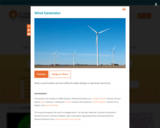
Investigating Density: Can water change density?
- Subject:
- Chemistry
- Science
- Material Type:
- Activity/Lab
- Provider:
- Science Education Resource Center (SERC) at Carleton College
- Provider Set:
- Pedagogy in Action
- Author:
- Sean Pajak
- Date Added:
- 02/24/2021

Investigating Density: Can water change density?

In this animated video segment adapted from NASA, astronomer Doris Daou explains how the forces of speed and gravity keep the Moon in a constant orbit around Earth.

Spreadsheets across the Curriculum module. Students use a spreadsheet to build a two-way table of drug level vs. time and elimination rate with parameters dosage interval and amount.

This activity is an in-class experiment where students predict, observe, and summarize what will happen when ice melts in a cup of water.

Windmills have been used for hundreds of years to collect energy from the wind in order to pump water, grind grain, and more recently generate electricity. There are many possible designs for the blades of a wind generator and engineers are always trying new ones. Design and test your own wind generator, then try to improve it by running a small electric motor connected to a voltage sensor.

Students learn how common pop culture references (Harry Potter books) can relate to chemistry. While making and demonstrating their own low-intensity sparklers (muggle-versions of magic wands), students learn and come to appreciate the chemistry involved (reaction rates, Gibb's free energy, process chemistry and metallurgy). The fun part is that all wands are personalized and depend on how well students conduct the lab. Students end the activity with a class duel a face-off between wands of two different chemical compositions. This lab serves as a fun, engaging review for stoichiometry, thermodynamics, redox and kinetics, as well as advanced placement course review.

A Khan Academy module that offers instruction and practice problems in exponents and scientific notation.
Khan Academy learning modules include a Community space where users can ask questions and seek help from community members. Educators should consult with their Technology administrators to determine the use of Khan Academy learning modules in their classroom. Please review materials from external sites before sharing with students.

This interactive resource from the Exploratorium calculates your weight on other bodies in our solar system and offers an explanation of mass and weight and the relationship between gravity, mass, and distance.